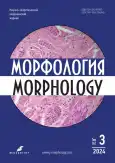Anatomy of the inferior pyramidal space tendon in the fetal and neonatal heart: a pilot study
- Authors: Yakimov A.A.1,2, Dmitrieva E.G.1,2, Gaponov A.A.1,2
-
Affiliations:
- Ural State Medical University
- Ural Federal University
- Issue: Vol 162, No 3 (2024)
- Pages: 276-286
- Section: Original Study Articles
- Submitted: 21.04.2024
- Accepted: 30.09.2024
- Published: 15.12.2024
- URL: https://j-morphology.com/1026-3543/article/view/630583
- DOI: https://doi.org/10.17816/morph.630583
- ID: 630583
Cite item
Abstract
BACKGROUND: Knowing the anatomical features of the inferior pyramidal space tendon of the fetal and neonatal heart (the tendon of Todaro, TT) is important for perinatal cardiac surgery (e.g., with access to the left atrium), but has been virtually unstudied.
AIM: The aim of the study was to evaluate the possibility of dissecting and evaluating the TT macromicroscopically and to obtain preliminary data on its presence, shape, size, branching and local topography in the fetal and neonatal heart.
MATERIALS AND METHODS: Fifteen samples of normal human hearts at 16–40 weeks of gestation were examined. Ten hearts were dissected under an Olympus SZX2-ZB10 microscope (Olympus, Japan) at a magnification ranging from 6.3 to 30×. The length and width of the TT were measured using a Levenhuk M1000 PLUS camera (Levenhuk, Russia) with a resolution of 10 Mpx and Levenhuk lite software. The arithmetic mean, standard deviation, median, extreme values, coefficient of variation and Spearman correlation coefficient (Rs) were calculated. Histologic sections were prepared from five hearts and stained using the Masson trichrome technique.
RESULTS: The TT was detected in all specimens and was always located in the intramyocardial space and/or in the loose connective tissue of the inferior pyramidal space. In all cases, the TT was originated from the right fibrous triangle, anterior to and above the atrioventricular bundle and node, where the TT was most monolithic. The TT then followed between the inferior border of the patent foramen ovale and the opening of the coronary sinus, ending at the valve of the inferior vena cava. In 6 out of 10 cases, the TT had no branches. In 4 out of 10 cases, it divided into two branches covering the opening of the coronary sinus. The TT fibers reaching the right coronary artery were dissected in one specimen. The median width of the TT at the inferior vena cava valve (0.35 mm) correlated with its length (4.63 mm; Rs = 0.821; p = 0.023) and width at the origin (0.24 mm; Rs = 0.929; p = 0.0003).
CONCLUSIONS: The inferior pyramidal space tendon of the heart in the late prenatal and perinatal period of human development is characterized by variable anatomy and constant topography. Variable structure is manifested by variations in tendon branching, a wide range of lengths and especially widths. Constant topography means that the tendon originates, runs, and ends in the same places. This tendon can be identified in fetal and neonatal hearts using macromicroscopic dissection.
Full Text
About the authors
Andrey A. Yakimov
Ural State Medical University; Ural Federal University
Author for correspondence.
Email: ayakimov07@mail.ru
ORCID iD: 0000-0001-8267-2895
SPIN-code: 8618-2991
MD, Cand. Sci. (Medicine), Associate Professor
Russian Federation, Ekaterinburg; EkaterinburgEugenia G. Dmitrieva
Ural State Medical University; Ural Federal University
Email: anmayak@mail.ru
ORCID iD: 0000-0002-2973-3481
SPIN-code: 7966-8133
Russian Federation, Ekaterinburg; Ekaterinburg
Anton A. Gaponov
Ural State Medical University; Ural Federal University
Email: gagaponov@gmail.com
ORCID iD: 0000-0002-6681-7537
SPIN-code: 2841-6740
Russian Federation, Ekaterinburg; Ekaterinburg
References
- Saremi F, Sánchez-Quintana D, Mori S, et al. Fibrous skeleton of the heart: anatomic overview and evaluation of pathologic conditions with CT and MR imaging. Radiographics. 2017;37(5):1330–1351. doi: 10.1148/rg.2017170004
- Glyantsev SP, Gordeeva MV. Eponymous names of topographic landmarks and anatomical structures of a normally formed heart. Pt 1. Eponyms of the pericardium, atria and ventricles of the heart. Minimally Invasive Cardiovascular Surgery. 2023;2(2):5–17.
- Tandler J. Anatomie des Herzens. Jena: Verlag von G. Fischer; 1913. (In Deutch).
- Ho SY, Anderson RH. How constant anatomically is the tendon of Todaro as a marker for the triangle of Koch? J Cardiovasc Electrophysiol. 2000;11(1):83–89. doi: 10.1111/j.1540-8167.2000.tb00741.x
- Voboril Z. Todaro’s tendon in the heart. I. Todaro’s tendon in the normal human heart. Folia Morphol (Praha). 1967;15(2):187–196.
- Kozłowski D, Grzybiak M, Koźluk E, Owerczuk A. Morphology of the tendon of Todaro within the human heart in ontogenesis. Folia Morphol (Warsz). 2000;59(3):201–206.
- James TN. The tendons of Todaro and the “triangle of Koch”: lessons from eponymous hagiolatry. J Cardiovasc Electrophysiol. 1999;10(11):1478–1496. doi: 10.1111/j.1540-8167.1999.tb00207.x
- Shanubhogue S, Mohamed T, Shankar N. Morphometry of the triangle of Koch and position of the coronary sinus opening in cadaveric fetal hearts. Indian Heart J. 2017;69(1):125–128. doi: 10.1016/j.ihj.2016.07.004
- Domènech-Mateu JM, Martínez-Pozo A, Arnó-Palau A. Development of the tendon of Todaro during the human embryonic and fetal periods. Anat Rec. 1994;238(3):374–382. doi: 10.1002/ar.1092380312
- Bashmakova NV, Kosovtsova NV. Fetal surgery: achievements and challenges. Doctor Ru. 2017;(13-14):31–36. EDN: TAUUWD
- Spicer DE, Anderson RH. Normal Cardiac Anatomy. In: Abdulla R., editor. Pediatric Cardiology. Springer, Cham. 2023. doi: 10.1007/978-3-030-42937-9_103-1
- Ferraz-de-Carvalho CA, Liberti EA. The membranous part of the human interventricular cardiac septum. Surg Radiol Anat. 1998;20(1):13–21. doi: 10.1007/s00276-998-0013-6
- https://fipat.library.dal.ca/ [Internet]. FIPAT. Terminologia Anatomica. 2nd ed. 2019. Available from: https://fipat.library.dal.ca/ta2/
- Mori S, Nishii T, Takaya T, et al. Clinical structural anatomy of the inferior pyramidal space reconstructed from the living heart: Three-dimensional visualization using multidetector-row computed tomography. Clin Anat. 2015;28(7):878–887. doi: 10.1002/ca.22483
Supplementary files











